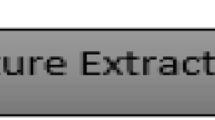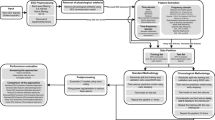Abstract
Abnormality detection has advanced in recent years with the help of machine learning, in particular with deep learning models, which can predict accurately across many types of signals and applications. In the case of neuronal signals, abnormalities can present themselves as artefacts or manifestations of neurological diseases. Among the diverse neuronal pathologies, we chose to look at the detection of seizures, as they manifest as a brief anomaly in contrast to normal brain activity in the majority portion of the data during a prolonged recording. Epileptic patients benefit from portable systems, which are dependant on efficient energy consumption, and the sampling frequency of the signal is of vital importance element to its battery lifespan. In this article, the impact of the sampling rate on a deep learning-based multi-class classification model is explored via the use of an open-source seizure dataset.
Access this chapter
Tax calculation will be finalised at checkout
Purchases are for personal use only
Similar content being viewed by others
References
Ali, H.M., Kaiser, M.S., Mahmud, M.: Application of convolutional neural network in segmenting brain regions from mri data. In: Liang, P., Goel, V., Shan, C. (eds.) Brain Informatics. Lecture Notes in Computer Science, pp. 136–146. Springer International Publishing, Cham (2019)
Aprile, C., et al.: Learning-based near-optimal area-power trade-offs in hardware design for neural signal acquisition. In: 2016 International Great Lakes Symposium on VLSI (GLSVLSI), pp. 433–438. Ieee (2016)
Aprile, C., et al.: Adaptive learning-based compressive sampling for low-power wireless implants. IEEE Trans. Circ. Syst. I Regul. Pap. 65(11), 3929–3941 (2018)
Aradhya, M.V.N., et al.: One shot cluster based approach for the detection of COVID–19 from Chest X–Ray images. Cogn. Comput. 1–9 (2021). https://doi.org/10.1007/s12559-020-09774-w
Baldassarre, L., Aprile, C., Shoaran, M., Leblebici, Y., Cevher, V.: Structured sampling and recovery of ieeg signals. In: 2015 IEEE 6th International Workshop on Computational Advances in Multi-Sensor Adaptive Processing (CAMSAP), pp. 269–272. IEEE (2015)
van Blooijs, D., Demuru, M., Zweiphenning, W., Leijten, F., Zijlmans, M.: Dataset clinical epilepsy ieeg to bids - respect longterm ieeg (2020). https://doi.org/10.18112/openneuro.ds003399.v1.0.1
Burrello, A., Cavigelli, L., Schindler, K., Benini, L., Rahimi, A.: Laelaps: an energy-efficient seizure detection algorithm from long-term human ieeg recordings without false alarms (2019). https://doi.org/10.3929/ETHZ-B-000307983
Chiang, J., Ward, R.K.: Energy-efficient data reduction techniques for wireless seizure detection systems. Sensors 14(2), 2036–2051 (2014)
Davis, K.A., et al.: The effect of increased intracranial EEG sampling rates in clinical practice. Clin. Neurophysiol. 129(2), 360–367 (2018)
Dey, N., Rajinikanth, V., Fong, S.J., Kaiser, M.S., Mahmud, M.: Social group optimization–assisted Kapur’s entropy and morphological segmentation for automated detection of COVID-19 infection from computed tomography images. Cogn. Comput. 12(5), 1011–1023 (2020). https://doi.org/10.1007/s12559-020-09751-3
Dlugosz, R., Iniewski, K.: Ultra low power current-mode algorithmic analog-to-digital converter implemented in 0.18/spl mu/m cmos technology for wireless sensor network. In: Proceedings of the International Conference Mixed Design of Integrated Circuits and System, 2006. MIXDES 2006, pp. 401–406. IEEE (2006)
Fabietti, M., et al.: Artifact detection in chronically recorded local field potentials using long-short term memory neural network. In: 2020 IEEE 14th International Conference on Application of Information and Communication Technologies (AICT), pp. 1–6 (2020). https://doi.org/10.1109/AICT50176.2020.9368638
Fabietti, M., et al.: Neural network-based artifact detection in local field potentials recorded from chronically implanted neural probes. In: Proceedings of the International Joint Conference on Neural Networks, pp. 1–8 (2020)
Fabietti, M., et al.: Adaptation of convolutional neural networks for multi-channel artifact detection in chronically recorded local field potentials. In: 2020 IEEE Symposium Series on Computational Intelligence (SSCI), pp. 1607–1613. IEEE (2020)
Fedele, T., et al.: High frequency oscillations detected in the intracranial EEG of epilepsy patients during interictal sleep, patients electrode location and outcome of epilepsy surgery (2017). https://doi.org/10.6080/K06Q1VD5
Gliske, S.V., Irwin, Z.T., Chestek, C., Stacey, W.C.: Effect of sampling rate and filter settings on high frequency oscillation detections. Clin. Neurophysiol. 127(9), 3042–3050 (2016)
Heller, S., et al.: Hardware implementation of a performance and energy-optimized convolutional neural network for seizure detection. In: 2018 40th Annual International Conference of the IEEE Engineering in Medicine and Biology Society (EMBC), pp. 2268–2271. IEEE (2018)
Kaiser, M.S., et al.: iWorksafe: towards healthy workplaces during COVID-19 with an intelligent Phealth app for industrial settings. IEEE Access 9, 13814–13828 (2021)
Kamboh, A.M., Oweiss, K.G., Mason, A.J.: Resource constrained VLSI architecture for implantable neural data compression systems. In: 2009 IEEE International Symposium on Circuits and Systems, pp. 1481–1484. IEEE (2009)
Kelleher, D., Faul, S., Temko, A., Marnane, W.: On the effect of reduced sampling rate and bitwidth on seizure detection. In: 2009 IEEE International Symposium on Intelligent Signal Processing, pp. 153–156. IEEE (2009)
Krizhevsky, A., Sutskever, I., Hinton, G.E.: Imagenet classification with deep convolutional neural networks. In: Advances in neural information processing systems, pp. 1097–1105 (2012)
Kuhlmann, L., et al.: Epilepsyecosystem. org: crowd-sourcing reproducible seizure prediction with long-term human intracranial EEG. Brain 141(9), 2619–2630 (2018)
Li, A., et al.: epilepsy-iEEG-multicenter-dataset (2020). https://doi.org/10.18112/openneuro.ds003029.v1.0.2
Liu, X., Wu, J.: A method for energy balance and data transmission optimal routing in wireless sensor networks. Sensors 19(13), 3017 (2019)
Mahmud, M., Kaiser, M.S., McGinnity, T.M., Hussain, A.: Deep learning in mining biological data. Cogn. Comput. 13(1), 1–33 (2020). https://doi.org/10.1007/s12559-020-09773-x
Mahmud, M., Kaiser, M.S., Hussain, A., Vassanelli, S.: Applications of deep learning and reinforcement learning to biological data. IEEE Trans. Neural Netw. Learn. Syst. 29(6), 2063–2079 (2018). https://doi.org/10.1109/TNNLS.2018.2790388
Miah, Y., Prima, C.N.E., Seema, S.J., Mahmud, M., Shamim Kaiser, M.: Performance comparison of machine learning techniques in identifying dementia from open access clinical datasets. In: Saeed, F., Al-Hadhrami, T., Mohammed, F., Mohammed, E. (eds.) Advances on Smart and Soft Computing. AISC, vol. 1188, pp. 79–89. Springer, Singapore (2021). https://doi.org/10.1007/978-981-15-6048-4_8
Nejedly, P.: Multicenter intracranial eeg dataset (2019). https://www.kaggle.com/nejedlypetr/multicenter-intracranial-eeg-dataset. Accessed 14 Mar 2021
Noor, M.B.T., Zenia, N.Z., Kaiser, M.S., Mahmud, M., Al Mamun, S.: Detecting neurodegenerative disease from MRI: a brief review on a deep learning perspective. In: Liang, P., Goel, V., Shan, C. (eds.) Brain Informatics. Lecture Notes in Computer Science, pp. 115–125. Springer International Publishing, Cham (2019). https://doi.org/10.1007/978-3-030-37078-7_12
Orojo, O., Tepper, J., McGinnity, T., Mahmud, M.: A multi-recurrent network for crude oil price prediction. In: Proceedings of the Symposium Series on Computational Intelligence, pp. 2940–2945, December 2019. https://doi.org/10.1109/SSCI44817.2019.9002841
Pang, G., Shen, C., Cao, L., Hengel, A.V.D.: Deep learning for anomaly detection: a review. arXiv preprint arXiv:2007.02500 (2020)
Rabby, G., Azad, S., Mahmud, M., Zamli, K.Z., Rahman, M.M.: TeKET: a tree-based unsupervised keyphrase extraction technique. Cogn. Comput. 12(4), 811–833 (2020). https://doi.org/10.1007/s12559-019-09706-3
Rasheed, K., et al.: Machine learning for predicting epileptic seizuresusing EEG signals: a review. IEEE Reviews in Biomedical Engineering (2020)
Schalk, G., Leuthardt, E.C.: Brain-computer interfaces using electrocorticographic signals. IEEE Rev. Biomed. Eng. 4, 140–154 (2011)
Shoaran, M., Kamal, M.H., Pollo, C., Vandergheynst, P., Schmid, A.: Compact low-power cortical recording architecture for compressive multichannel data acquisition. IEEE Trans. Biomed. Circ. Syst. 8(6), 857–870 (2014)
Shrivastwa, R.R., Pudi, V., Chattopadhyay, A.: An FPGA-based brain computer interfacing using compressive sensing and machine learning. In: 2018 IEEE Computer Society Annual Symposium on VLSI (ISVLSI), pp. 726–731. IEEE (2018)
Tania, M.H., et al.: Assay type detection using advanced machine learning algorithms. In: Proceedings of the Software, Knowledge, Information Management and Applications, pp. 1–8 (2019)
Temko, A., Sarkar, A., Lightbody, G.: Detection of seizures in intracranial EEG: UPenn and mayo clinic’s seizure detection challenge. In: Proceedings of the Engineering in Medicine and Biology Society, pp. 6582–6585 (2015). https://www.kaggle.com/c/seizure-detection. Accessed 14 June 2020
Truong, N.D., et al.: Integer convolutional neural network for seizure detection. IEEE J. Emerg. Sel. Top. Circuit. Syst. 8(4), 849–857 (2018)
Watkins, J., Fabietti, M., Mahmud, M.: Sense: a student performance quantifier using sentiment analysis. In: Proceedings of the International Joint Conference on Neural Networks, pp. 1–6 (2020)
Yahaya, S.W., Lotfi, A., Mahmud, M.: A consensus novelty detection ensembleapproach for anomaly detection in activities of daily living. Appl. Soft Comput. 83, 105613 (2019)
Yahaya, S.W., Lotfi, A., Mahmud, M., Machado, P., Kubota, N.: Gesture recognition intermediary robot for abnormality detection in human activities. In: Proceedings of the Symposium Series on Computational Intelligence, pp. 1415–1421, December 2019. https://doi.org/10.1109/SSCI44817.2019.9003121
Author information
Authors and Affiliations
Corresponding author
Editor information
Editors and Affiliations
Rights and permissions
Copyright information
© 2021 Springer Nature Switzerland AG
About this paper
Cite this paper
Fabietti, M., Mahmud, M., Lotfi, A. (2021). Anomaly Detection in Invasively Recorded Neuronal Signals Using Deep Neural Network: Effect of Sampling Frequency. In: Mahmud, M., Kaiser, M.S., Kasabov, N., Iftekharuddin, K., Zhong, N. (eds) Applied Intelligence and Informatics. AII 2021. Communications in Computer and Information Science, vol 1435. Springer, Cham. https://doi.org/10.1007/978-3-030-82269-9_7
Download citation
DOI: https://doi.org/10.1007/978-3-030-82269-9_7
Published:
Publisher Name: Springer, Cham
Print ISBN: 978-3-030-82268-2
Online ISBN: 978-3-030-82269-9
eBook Packages: Computer ScienceComputer Science (R0)




